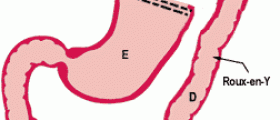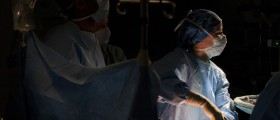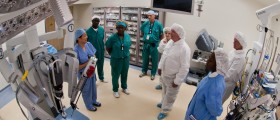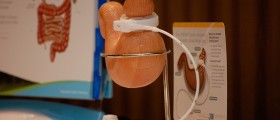
Bariatric Surgery
Nowadays, there is an outbreak of obesity which affects one-third of all adults in US. Weight loss surgery or bariatric surgery is very popular and effective solution for obesity.
Weight loss surgery is an option for those extremely obese. This procedure involves reducing the volume of the stomach in order for a patient to lose weight. This can be achieved in three ways:By implanted medical device – gastric banding.Through removal of part of the stomach – sleeve gastrectomy or biliopancreatic diversion with duodenal switch.By resecting and re-routing the small intestines to a small stomach pouch – gastric bypass surgery.Complications of Bariatric Surgery
Bariatric surgery is associated to risk of gallstones formation. It occurs in 38% of the cases after the surgery. Bariatric surgery also increases occurrence of inflammatory hepatitis due to weight loss.
Vertical banded gastroplasty involves deterioration of the band and sometimes this can lead to leaking of stomach juices into abdomen. Restrictive surgery is connected to risk of vomiting and nutritional deficiencies. Approximately 30% of the patients develop nutritional deficiencies such as anemia, osteoporosis and metabolic bone disease. Up to 20% of patients who undergo bariatric surgery may need additional operations to correct the complications. Most commonly it is abdominal hernia. Breakdown of the staple line and stretched stomach outlets occur in lower rate. “Dumping syndrome” can be developed as a result of Roux-en-Y gastric and BPD surgeries, with associated symptoms such as weakness, nausea, diarrhea, and faintness.
Intraoperative Complications
These complications include:BleedingInadvertent injury to the GI tractStapling misadventuresGenerally, intraoperative complications rarely take place, and can be easily avoided and corrected.
Postoperative Complications
Leading cause of death in weight loss surgery patients is pulmonary embolism and the incidence is up to 2%. Gastrointestinal leaks are also seen in 2% of the patients. This problem can be recognized by increased leukocyte count, persistent tachycardia and progressive tachypnea.
Major wound infection may also develop and the incidence is in the range 1% to 3%. On the other hand, seromas in the subcutaneous fatty liver are more common.
Patients may experience gastrointestinal bleeding due to marginal ulcerations, gastritis, bleeding from the fresh staple line or ulcers in the bypassed stomach or duodenum.
Small bowel obstruction can occur in 1% to 2% of the patients and this can be treated by tube decompression. Cardiorespiratory complications are very rare.
Late complications include incisional hernia, symptomatic gallbladder disease, marginal ulcers and intractable vomiting. Patients who have gastric bypass may develop metabolic sequelae. This can be treated with vitamin and mineral supplements.
















Your thoughts on this
Loading...